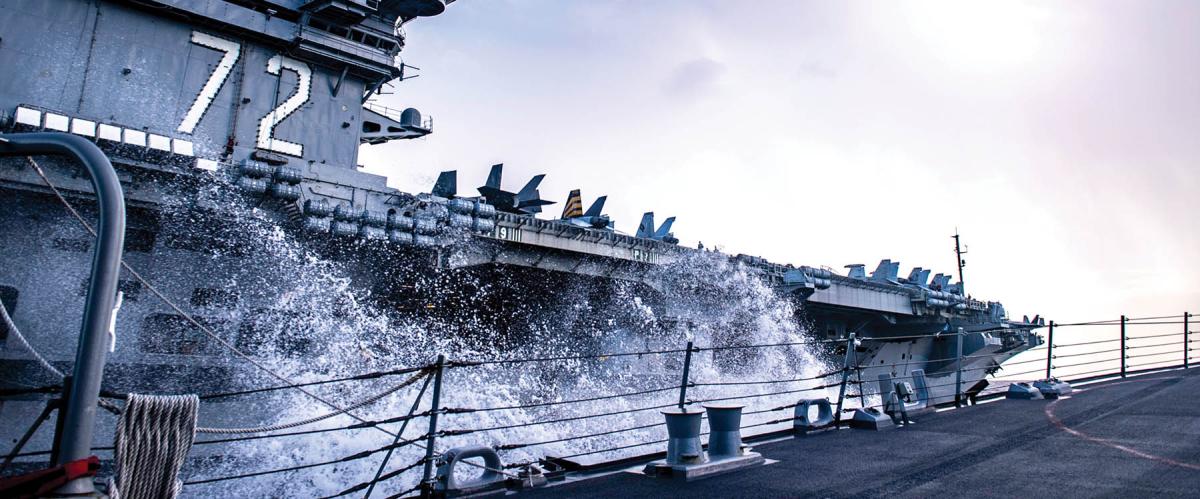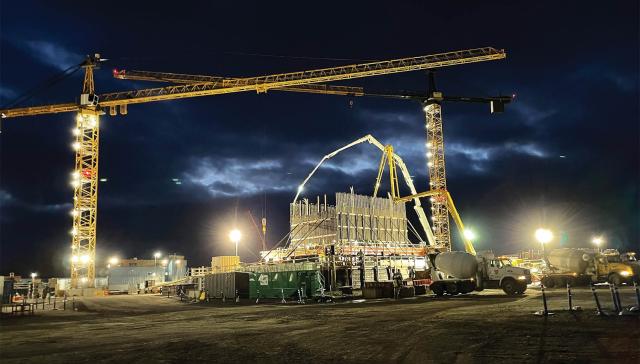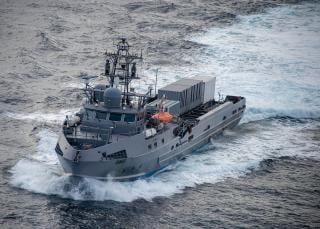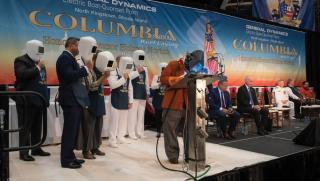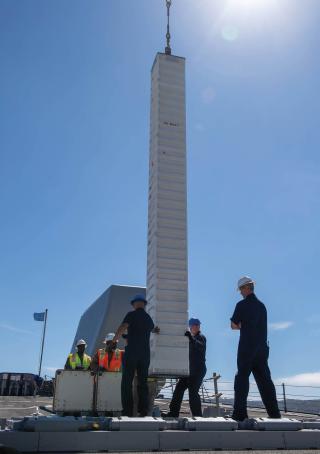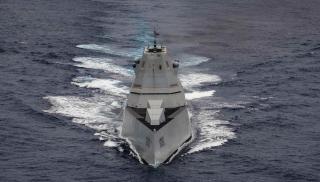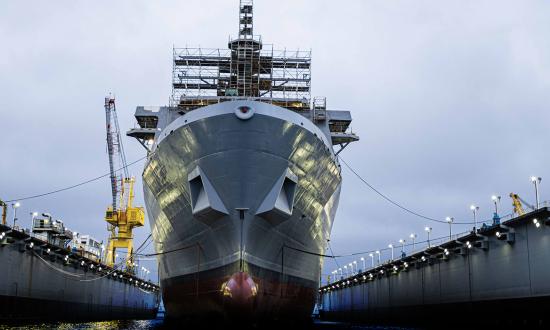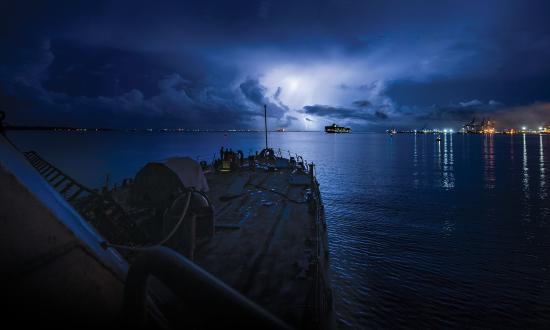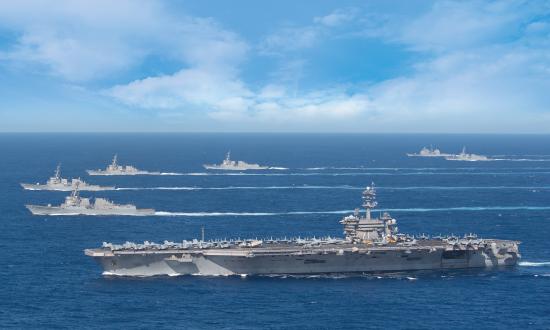Barrels of ink have been expended in recent years across the pages of Proceedings and other media warning about the state of the U.S. Navy. We are all familiar with the near-constant refrain: The fleet is too small and must quickly expand in size; the nation is not buying the right mix of ships and systems in the right numbers; Navy leaders are not advocating sufficiently for the strategic value of maritime forces and are “losing” in Pentagon budget battles.
“Every day, our Navy is sinking deeper into hollowness,” opined a commentary in 2022, adding that the “Navy’s problems are now so complex and interdependent that they are probably beyond the service’s capability by itself to solve.”1 According to another expert, the Navy’s “divest to invest” funding strategy shrinks Navy capacity upfront and counts on new “wonder weapons” still on the drawing board to pay off sometime in the future.2
While these are all useful perspectives, it is valuable to step back and inventory the critical new systems, capabilities, and concepts the Navy is developing and has deployed in recent years—or is close to fielding. This is not meant to be an exhaustive list of every program. Rather, it is meant to highlight that, despite the lamentations, the Navy is making progress in advancing the fleet, with a new generation of maritime capabilities replenishing the current battle force.
While funding and the size of the Navy budget are always contentious issues in Washington, the service has been on a funding roll of late, especially in shipbuilding. Over the past three years, beginning with the 2021 appropriations bill and extending to the just-enacted 2023 legislation, the total amount of funding for naval shipbuilding has increased each year at congressional direction. One can argue that Congress is driving this increase and not the Navy, but in the final analysis more investment is going into the construction of the future fleet.
In the 2021 budget, Congress appropriated $23.3 billion, compared with the requested amount of $19.9 billion. In 2022, Congress added $4.71 billion to the Navy’s $22.5 billion request. The just-enacted 2023 budget provides $31.9 billion for shipbuilding—a $4 billion increase.3 The funding being invested in naval shipbuilding is increasing in dramatic fashion. The fiscal year (FY) 2023 total is $12 billion higher than the $19.9 billion the Navy was requesting only three years ago. That equates to a 37.6 percent increase in funding for shipbuilding since 2021.
This congressional focus on naval matters is not limited to providing more funding for ships and weapons. The 2023 budget also includes the creation of a new National Commission on the Future of the Navy, whose writ is to assess the future force structure and make specific policy recommendations on the types of ships and aircraft the service should procure to meet future requirements and operational demands.
To accomplish this task, Congress directed the commission to assess plans using four different funding levels, ranging from the current budget to budgets growing at 3 and 5 percent, respectively, and then to assess a force unconstrained by costs. The commission is also directed to assess the state of the nation’s shipyards and repair facilities and offer recommendations for injecting greater use of advanced technologies, such as artificial intelligence, into the fleet. An unclassified report is required by 1 July 2024.4
Shipbuilding Is Growing
According to Navy Secretary Carlos Del Toro, the Navy now has 54 ships under construction, emphasizing that these are the “right ships” for the service to be building today.5 Adding the Columbia-class strategic ballistic-missile submarine effort, ongoing construction of the Virginia-class nuclear attack submarine with the Virginia Payload Module, two Gerald R. Ford–class aircraft carriers, and three Constellation-class frigates entering construction to Secretary Del Toro’s 54 ships noted above, the nation’s major shipyards are approaching the limits of their building capacity.
Chief of Naval Operations Admiral Michael Gilday has noted, “We have an industrial capacity that’s limited. In other words, we can only get so many ships off the production line a year. My goal would be to optimize those production lines for destroyers, for frigates, for amphibious ships, for the light amphibious ships, for supply ships.”6 He added that industry requires clear “signals” from the Navy on acquisition to initiate the costly expenditures required to boost overall shipbuilding capacity.
Unmanned Emerges
The past year witnessed some remarkable achievements in pushing forward the concept of a hybrid fleet composed of manned and unmanned ships and aircraft. These advancements were achieved across the entire spectrum of naval operations, from developmental and operational testing, to experiments with a wide range of prototypes, up to real fleet deployments. The Navy’s special Pentagon-based Task Force Unmanned has also conducted a series of “sprints” on specific unmanned issues but has said little publicly about its overall goals or if it has achieved any successes.7
The biennial Rim of the Pacific (RimPac) exercise conducted in the waters around the Hawaiian Islands was a standout success and a window into how the future hybrid fleet might operate. Conducted between June and August, RimPac witnessed the deployment of four prototype unmanned surface vessels (USVs), the trimarans Sea Hunter and Seahawk and two converted offshore supply vessels, the Nomad and Ranger. The four USVs conducted a variety of missions using different payloads—all while controlled from either a small team deployed on board an Arleigh Burke–class guided-missile destroyer or, for the first time, from a land-based unmanned-vehicle operations center.8
Another prototype USV, the Mariner, was delivered in 2022 and after outfitting is expected to join the rapidly growing USV Division 1 (USVDiv1) unit on the West Coast. That unit was officially established in May 2022 as the fleet-based testing arm for USVs and their associated autonomy systems and payloads. It also operates the unmanned-vehicle operations center located at Port Hueneme, California. “We’re at a level of evolution for how we are doing these types of testing events where you need a dedicated command that’s focused on bringing forward the technology, the lethality, the interconnectedness and finding out the right tactics, techniques, and procedures for how we are going to interact and work with the fleet,” said Commander Jeremiah Daley, who commands USVDiv1.9
At congressional direction and using directed funding, the Navy also experimented with the AustalUSA-built USS Apalachicola (EPF-13) as an autonomous logistics vessel, conducting a series of five autonomous transits across the Gulf of Mexico.10 EPF-13 is the largest ship with which the Navy has demonstrated autonomous capability and could be a useful prototype for better understanding the capabilities and operational attributes the service requires for the still-notional large USV, whose mission is to be an adjunct missile magazine for the surface fleet.
The Navy also declared initial operating capability (IOC) for the smaller Unmanned Influence Sweep System (UISS), an important component in the mine countermeasures mission (MCM) package for the littoral combat ship. UISS is the first USV program of record. Following the IOC declaration, the Navy awarded Bollinger Shipyard, located in Lockport, Louisiana, a production contract to build as many as 24 UISSs. “This craft, having it IOC, which means it’s through test, which means we have numbers fielded, which means we have trained crews, which means we have logistics set up. . . . It’s just a huge milestone to get that done for our first surface MCM platform,” said Rear Admiral Casey Moton, program executive officer for unmanned and small combatants.11
The fleet, too, has ramped up its interest in unmanned experimentation and testing, with the Pacific Fleet leading the RimPac exercises and U.S. Fifth Fleet in Bahrain establishing Task Force 59 (TF-59), whose rapid pace of exercises and testing has garnered intense interest from Navy leaders, defense firms, and Congress. In April 2022, for example, TF-59 successfully used 80 unmanned systems in an exercise operated by 10 different nations.12
Using an innovative acquisition model, TF-59 leases and operates a diverse mix of unmanned gliders and small autonomous vessels, such as Saildrones and MANTAS USVs, supported and maintained by contractors. This model has enabled Fifth Fleet to conduct a series of progressively larger and more complex exercises, which are designed to enhance regional situational awareness and provide a comprehensive picture of operations from the Red Sea to the Arabian Gulf. Fifth Fleet is planning for a larger, 100-unmanned-systems exercise in May 2023.13
Block V Virginia-class SSNs and the Virginia Payload Module
Despite China modernizing its military and closing the gap on many U.S. strengths, the U.S. submarine force remains an area of enduring asymmetric advantage.14 The Virginia-class fast-attack submarine has been central to maintaining this edge, and its capability will grow in the coming years. The Virginia Payload Module (VPM) will deliver a major increase in U.S. undersea firepower and present adversaries with a highly distributed threat. The keel-laying of the first VPM-capable submarine—the future Arizona (SSN-803)—occurred 7 December 2022, the 81st anniversary of the attack on Pearl Harbor.15
The Navy first selected its VPM concept design in late 2013.16 It extends the length of the Virginia-class submarine by 84 feet to include a new hull section featuring four large-diameter payload tubes.17 These launchers add a combined 28 launch cells, bringing the total number of missiles that can be fielded in vertical launchers to 40 per submarine. The VPM will be implemented beginning with the 30th ship of the class, the Arizona, which will be the second submarine of the Block V production run. This is the first warship to bear the name since the battleship USS Arizona (BB-39) was sunk in the attack on Pearl Harbor.18
The VPM requirement is linked to the forthcoming decommissioning of the Navy’s four Ohio-class guided-missile submarines (SSGNs). These submarines were converted from the nuclear-deterrent mission into warships featuring considerable conventional capability, with each fielding 154 missile tubes. They are the first four boats of the Ohio class and are the oldest submarines in the force.19 Each will have served for more than 40 years at the time of their expected decommissioning during the FY26–28 timeframe.20 Their decommissioning will decrease the Navy’s undersea conventional missile launch capacity by 616 tubes, which would require 22 VPMs to reconstitute. At a production rate of two Virginia-class boats per year, this is unlikely to happen until the 2040s.
Columbia-class SSBNs
Ballistic-missile submarines (SSBNs) field more than 70 percent of the nation’s nuclear arsenal and are considered the most survivable leg of the nuclear triad.21 After many decades of service, the Ohio-class SSBNs are set to retire in the coming years. The keel-laying of the first boat of the Columbia-class took place in June 2022.22 The first-in-class of the new submarine, the USS District of Columbia (SSBN-826), is expected to make its first strategic deterrent patrol in 2031, 50 years after the first Ohio-class boat was commissioned, and is expected to serve until the 2080s.23
The class will consist of 12 boats, down from the 14 existing nuclear-capable Ohio-class boats. The Columbia class will meet existing operational requirements with fewer boats by fielding a new nuclear reactor, one of its chief enhancements. The new reactor is expected to serve through the full life of the hull, eliminating the need for a costly and time-consuming mid-life refueling overhaul. While the Columbia-class boats are still expected to require mid-life overhauls for purposes unrelated to refueling, the overhauls are expected to require roughly half the time of the more extensive Ohio-class overhauls.24
The Columbia class will be slightly larger than the Ohio class with a fully submerged displacement of nearly 21,000 tons, making it the largest U.S. submarine ever constructed.25 Despite the larger displacement, the Columbia class will feature a reduction in payload capacity, featuring 16 submarine-launched ballistic-missile (SLBM) tubes compared with the 24 of the Ohio class.26 This reduction lowers the cost of the program while retaining enough capability to meet projected needs.27
Senior Navy officials have consistently stated that the Columbia-class submarine is the service’s top procurement priority, implying the program will secure the funding it needs even if it must be drawn from other Navy programs.28 In its FY2023 budget estimate, the Navy estimated the total procurement cost of the program at $112 billion for the 12-boat class. The lead boat of the class is expected to cost more than $15 billion, making it the most expensive warship ever built, surpassing even the USS Gerald R. Ford (CVN-78). The rest of the Columbia class is expected to average about $7.4 billion per boat.29 However, the Government Accountability Office has argued that the Navy’s cost estimates for the program are “overly optimistic,” and the delivery schedule of the first boat is “aggressive and leaves little room for error.”30
The Columbia class could serve the nation and its nuclear deterrent mission for decades. But the class may have another, less-helpful legacy. Its significant cost and the Navy’s steadfast commitment to see the program to completion place considerable pressure on the shipbuilding budget more broadly. This pressure may result in a reduction of planned procurement quantities of other warships and lead to a smaller Navy than projected.31
Block V Tomahawk Cruise Missile
The Tomahawk cruise missile has been at the forefront of much of the Navy’s power projection capability in recent decades. The widely fielded missile provides a standoff capability with high volume of fire, offering commanders and decision-makers a variety of options for influencing events ashore. Introduced in 1984 and first fired in combat in the 1991 Gulf War, the Tomahawk is expected to continue serving for decades.32 The first Block V Tomahawks were delivered to the Navy in 2021.33 All existing Navy Block IV Tomahawks will be recertified and upgraded into Block V variants in the coming years.34
Block V introduces upgrades that enhance the Tomahawk’s capabilities, especially for high-end warfighting. These upgrades include electronic hardening of communication and navigation systems that decrease the missile’s dependence on GPS while making it more difficult to jam.35 In a contested electromagnetic environment, these capabilities could prove critical in ensuring Tomahawk salvos can reach their targets even when lacking critical enablers.
Block V Tomahawks also will be coming to other services. With the demise of the U.S.-Russia Intermediate-Range Nuclear Forces (INF) treaty and a growing interest in land-based, long-range missile capability, the Navy issued a contract in 2022 for 154 Block V missiles to be split between the fleet, the Marine Corps, and the Army.36 The Tomahawk may play a critical enabling role for those other services’ concepts of expeditionary advanced base operations (EABO) and multidomain operations, respectively.
Block V will usher in a new generation of Tomahawk capability through other versions of the subvariant. Block Va will be the Maritime Strike Tomahawk that will give the Navy its longest-range antiship capability to date. This upgrade includes a seeker optimized for striking moving targets at sea.37 Maritime Strike Tomahawks are expected to join the fleet in 2024, more than 40 years after an antiship version first struck a warship target in testing.38
Block Vb will introduce the Joint Multi-Effects Warhead System (JMEWS), which will enhance the Tomahawk’s penetration capability to better threaten hardened and deeply buried targets, such as bunkers and underground facilities. Block Vb is expected to be delivered in FY27.39
Block V Tomahawk variants will enhance the Navy’s power-projection capability and be its first truly cross-platform, long-range antiship weapon. But the surface fleet and submarine force field thousands of launch cells, which demand a high rate of Tomahawk recertification and upgrading to produce the weapon in operationally meaningful numbers in the near-term. Procurement projections suggest the Navy is planning to upgrade around 150–300 Tomahawks per year.40 This indicates it could take the Navy nearly two decades to make Block V Tomahawks common across the force with a deep inventory of munitions. The Navy’s desire to upgrade its Tomahawks may also compete for limited production capacity with the other services interested in procuring them. Given the high volumes of fire expected for great power conflict and naval salvo combat, it may be years before the Navy has enough breadth and depth of inventory across its magazines to fully operationalize Block V capabilities.
SEWIP Block III
As ships face down salvos of incoming antiship missiles, electronic warfare may prove vital to self-defense. By offering soft-kill systems with effectively bottomless magazines, electronic warfare can provide enduring defensive capability while other weapon systems become depleted. The Navy is on the verge of fielding the next generation of surface-ship electronic warfare capability—the Surface Electronic Warfare Improvement Program (SEWIP) Block III. The first shipboard installation began in 2022 with the guided-missile destroyer USS Pinckney (DDG-91).41
The large surface combatants currently field the Block II version of SEWIP, which offers passive detection and classification capabilities of radiofrequency signatures that help warships understand the threat environment with minimal sensing. Block III will introduce an electronic-attack capability that enhances the ability to counter incoming threats from antiship missiles and other emitters.43 It also adds a “cognitive” electronic warfare capability, with which SEWIP Block III can help operators identify novel electronic signatures that do not appear in existing signature libraries. In addition, Block III may eventually be able to develop new electronic warfare techniques and jamming methods on the fly.44 After initial installation and testing on the Pinckney, SEWIP Block III will be installed on new-construction destroyers in the coming years and on existing ships through the DDG Mod 2.0 upgrade program.45
SEWIP Block III requires extensive modifications to the superstructure of the destroyers for installation. Two sponsons are added to each side of the superstructure, placing the large system between the forward- and aft-facing radar arrays on either side. These protrusions allow the system to provide full coverage over four quadrants surrounding the ship.46 The considerable scope of these modifications makes it challenging to install on smaller platforms. But industry is exploring options for creating a SEWIP “lite” that offers a scaled-down version of Block III for smaller warships.47
Flight III Arleigh Burke–class Destroyers
The Arleigh Burke class has been the mainstay of the surface force for decades. After numerous upgrades, the class is about to field its most capable variant yet—the Flight III destroyer. The future Jack H. Lucas (DDG-125) was christened on 26 March 2022 and completed builder’s trials on 15 December.48
The main enhancement of the Flight III class is the SPY-6(V)1 radar, also dubbed the Air and Missile Defense Radar (AMDR). The SPY-6 is claimed to have more than 30 times the sensitivity of the existing SPY-1 radar.49 This increase in sensitivity is advantageous for countering high-end air and missile threats. The Flight III class could be pivotal in defeating some of the most lethal threats to the fleet, including ballistic and hypersonic weapons. Program officials have stated the Navy plans to procure 14 Flight III destroyers thus far.50
The Flight III concept first became public in February 2010 when the Navy officially canceled the CG(X) program, the proposed successor to the Ticonderoga-class cruisers. The CG(X) program aimed to build on the hull of the DDG-1000 Zumwalt-class destroyers, but the truncation of that program in 2008 may have affected the Navy’s willingness to build on the hull form.51 The service offered Flight III as an alternative. These destroyers would be able to take advantage of the established DDG-51 production line and exploit the hull’s margin for new capability. However, the Flight III was expected to field an AMDR nearly 40 percent smaller than what was planned for CG(X).52
Finally, extensive upgrades to the DDG-51–class power and cooling systems were necessary to accommodate the SPY-6 radar, consuming most of the remaining margin in the DDG-51 hull. The Navy’s director of Surface Warfare Rear Admiral Paul Schlise recently stated that “there simply isn’t any more margin for growth.” The Navy will certainly be considering the lessons of Flight III as it refines concepts for its next-generation destroyer, the DDG(X).
Gerald R. Ford–class Carriers
The Gerald R. Ford–class aircraft carrier is the nation’s first new carrier design in nearly 50 years, intended to replace the Nimitz-class carriers as they reach the end of their service lives. After a lengthy and controversial construction period, the Navy sent the USS Gerald R. Ford (CVN-78) on its first deployment in October 2022.53
The Gerald R. Ford class incorporates 23 new technologies, including capabilities that enhance its sortie-generation rate by more than 25 percent over its predecessors.54 Chief among these is the electromagnetic aircraft launch system, which replaces the steam-powered catapults used on Nimitz-class carriers, and new weapon elevators that also function with electromagnetic technology. These two technologies are critical to the carrier’s enhanced sortie-generation capability but were plagued by technical issues during construction. Ultimately, these issues were resolved, and the carrier set a record for the most sorties launched in an 8.5-hour period—170 launches and 175 arrestments.55
The Gerald R. Ford class is expected to fully replace the Nimitz class in the coming decades, with the first four ships currently under contract. With each ship expected to serve up to 50 years, the carriers may remain in service beyond the year 2100.
Constellation-class Frigates
For the Navy’s new frigate, 2022 proved to be a pivotal year, as the shipbuilding program achieved several milestones and appears firmly on track for Wisconsin-based Fincantieri Marinette Marine (FMM) to deliver the first frigate in 2026. The Navy announced that construction commenced on the Constellation (FFG-62) in August and that the ship’s design was more than 80 percent complete.
The Navy awarded Fincantieri a contract in April 2020 for the first frigate and options for 10 additional ships. The Constellation class is based on a similar European multipurpose frigate (FREMM) design that FMM’s parent Italian company has been building for two NATO navies. The Navy’s current shipbuilding plan envisions 20 frigates. In addition to the Constellation, FMM is also under contract to build the future Congress (FFG-63), and the Navy exercised the contract option for the future Chesapeake (FFG-64) in June 2022.
When to increase frigate production to two (or more) ships per year and when (or if) a second shipyard should be brought online for frigate construction were debated in 2022, but no significant action resulted. Congress has repeatedly raised the issue of an additional shipyard for frigate construction but has proffered no new legislation.
Navy officials maintain a twofold stance. First, they argue that any decision to expand procurement of the yearly number of frigates should be held until the Constellation’s construction is more advanced and FMM has a firm grasp of the ship’s design and construction specifics. Second, built into the production contract with FMM is a provision that allows the Navy to buy the ship’s Technical Design Package, which the service could then compete among other shipyards for future frigate construction.56
Zumwalt DDGs, Hypersonics, and Zeus
The Navy now has a plan that lays out both the mission and the capabilities the service intends for the three-ship Zumwalt-class guided-missile destroyers. After years of semiserious outfitting and testing, the Navy will equip all three tumblehome hull–form ships with hypersonic cruise missiles coupled with a separate list of enhancements to the ship’s radar, self-defense, and combat systems. This performance upgrade will require removing the ship’s two 155-mm Advanced Gun Systems that were never proven to fire hypervelocity projectiles.
The Zumwalt and her two sister ships, the USS Michael Monsoor (DDG-1001) and Lyndon B. Johnson (DDG-1002), will be outfitted with at least a dozen of the Conventional Prompt Strike (CPS) hypervelocity missiles now in development, providing the destroyers a deep-strike capability with an estimated range of 1,700 miles while traveling at Mach 5. CPS weapons will be launched from Advanced Payload Modules—the same system being deployed on Virginia-class attack submarines.57
Operationally, the Zumwalt conducted her first deployment in 2022, operating in the western Pacific from August to November, exercising with other U.S. services, including the Army and Air Force, conducting simulated engagements alongside Japanese defense forces, and testing an experimental concept for mine countermeasures.58
The Zumwalt will enter an extended maintenance availability late in 2023 to integrate the hypersonic missiles and other offensive and defensive system upgrades. The improvements, called Zumwalt Enterprise Upgrade Solution (ZEUS), will include upgrading the Aegis SPY-3 dual-band radar to the more advanced SPY-6 version and installing new electronic warfare capabilities such as SEWIP and antisubmarine warfare systems. The installations will render the ship offline until sometime in 2025.59
The Navy is now in the throes of a real transformation based on the new generation of capabilities and platforms either in advanced development or soon to enter the fleet. These new systems will be at the forefront of naval deterrence and crisis response as the service implements distributed maritime operations.
Author's Note: As many readers of Proceedings are aware, Dr. Scott Truver has penned the Navy in Review article in its many forms since 1994. I have had the privilege of joining him in this endeavor starting in 2011. I would like to extend my gratitude and thanks to Scott for being a truly great colleague, mentor, co-worker and, most of all, true friend for more than three decades. As a rookie Navy reporter at Defense News, Scott was the first person I quoted in the first article that I ever wrote. That was the start of a great relationship. Years later Scott schooled me in how to transition to the defense contracting world. He continues to school me today. I am honored to continue forward with the annual Navy in Review article in the tradition and style that Scott established.
1. John Ferrari, “The Navy Is Broken. Congress Must Launch a Commission to Find the Path Forward,” Breaking Defense, 8 June 2022.
2. Brent Sadler, “The Navy’s Latest Shipbuilding Plan May Sink America’s Pacific Ambitions,” The National Interest, 28 April 2022.
3. “An Analysis of the Navy’s Fiscal Year 2023 Shipbuilding Plan,” Congressional Budget Office, 12 November 2022.
4. “Congress May Set Up a National Commission on the Future of the Navy,” Maritime Executive, 12 December 2022.
5. Megan Eckstein, “U.S. Navy Secretary Sees No Need to Rush Next-Gen Destroyer Program,” Defense News, 12 December 2022.
6. Mallory Shelbourne, “CNO Gilday: Industrial Capacity Largest Barrier to Growing the Fleet,” USNI News, 25 August 2022.
7. Richard Burgess, “Navy Unmanned Task Force Lead: Common Control System Critical to Enable Artificial Intelligence,” Seapower, 25 May 2022.
8. Gidget Fuentes, “New Navy Unmanned Command Will Send 4 Experimental Large USVs to RIMPAC,” USNI News, 11 May 2022.
9. Mallory Shelbourne, “New Navy Unmanned Division to Serve as Bridge Between Program Office, Fleet,” USNI News, 22 July 2022.
10. Richard R. Burgess, “Navy Ready to Christen New Overlord USV Mariner,” Seapower, 23 August 2022; “U.S. Navy’s EPF-13 Ship Concludes Acceptance and Uncrewed Logistics Trials,” Naval Technology, 12 September 2022.
11. Megan Eckstein, “RIMPAC Lessons Will Inform Navy’s Pursuit of a Program of Record Ship in 2025,” Defense News, 1 August 2022.
12. Jackson Barnett, “TF-59: The Future of the Navy’s Unmanned Systems or a One-Off Win?” FedScoop, 8 February 2022.
13. VADM Brad Cooper, USN, “Tests in Fifth Fleet a Bridge to Future,” U.S. Naval Institute Proceedings 148, no. 6 (June 2022).
14. Megan Eckstein, “SECDEF Esper Calls for 500-Ship Fleet by 2045, With 3 SSNs a Year and Light Carriers Supplementing CVNs,” USNI News, 6 October 2020.
15. Team Submarine Public Affairs, “Navy Authenticates Keel for Future USS Arizona (SSN-803),” 7 December 2022.
16. Sam LaGrone, “Navy Selects Virginia Payload Module Design Concept,” USNI News, 4 November 2013.
17. Ron O’Rourke, “Navy Virginia (SSN-774) Class Attack Submarine Procurement: Background and Issues for Congress,” Congressional Research Service, 21 December 2022, 10.
18. Team Submarine Public Affairs, “Navy Authenticates Keel.”
19. Naval Vessel Register, www.nvr.navy.mil/INDEX.HTM.
20. O’Rourke, “Navy Virginia (SSN-774) Class Attack Submarine Procurement.”
21. “Keel Laying Ceremony Held for First Columbia-Class Ballistic Missile Submarine,” Naval Sea Systems and Commander, Submarine Forces Public Affairs, 4 June 2022.
22. “Keel Laying Ceremony Held for First Columbia-Class Ballistic Missile Submarine.”
23. John Grady, “Keel Laid For Nuclear Ballistic Missile Submarine District of Columbia,” USNI News, 4 June 2022; and Ron O’Rourke, “Navy Columbia (SSBN-826) Class Ballistic Missile Submarine Program: Background and Issues for Congress,” Congressional Research Service, last updated 14 December 2022, 38.
24. O’Rourke, “Navy Columbia (SSBN-826) Class Ballistic Missile Submarine Program,” 5, 38.
25. O’Rourke, “Navy Columbia (SSBN-826) Class Ballistic Missile Submarine Program,” 39.
26. O’Rourke, “Navy Columbia (SSBN-826) Class Ballistic Missile Submarine Program,” 41.
27. O’Rourke, “Navy Columbia (SSBN-826) Class Ballistic Missile Submarine Program,” 42–44.
28. O’Rourke, “Navy Columbia (SSBN-826) Class Ballistic Missile Submarine Program,” 4.
29. Eric J. Labs, “An Analysis of the Navy’s Fiscal Year 2023 Shipbuilding Plan,” Congressional Budget Office, 10 November 2022.
30. “Columbia Class Submarine: Overly Optimistic Cost Estimate Will Likely Lead to Budget Increases,” Government Accountability Office, 8 April 2019.
31. Mackenzie Eaglen, “National Sea-Based Deterrence Fund: Myth vs. Reality,” Breaking Defense, 22 December 2015.
32. Norman Polmar and Thomas B. Allen, “Naval Weapon of Choice,” Naval History Magazine 30, no. 1 (February 2016).
33. “Navy Completes First Delivery of Block V Tomahawk Missile,” Naval Air Systems Command, 25 March 2021.
34. “Navy Completes First Delivery of Block V Tomahawk Missile,” 25 March 2021.
35. David B. Larter, “The U.S. Navy Has an Upgraded Tomahawk: Here’s 5 Things You Should Know,” Defense News, 14 December 2020.
36. Mallory Shelbourne, “Raytheon Awarded $217M Tomahawk Missiles Contract for Navy, Marines, Army,” USNI News, 25 May 2022.
37. John Grady, “Entire Navy Tomahawk Missile Arsenal Will Upgrade to Block V,” USNI News, 22 January 2020.
38. Edward J. Walsh, “Tomahawks Getting More Lethal,” U.S. Naval Institute Proceedings 148, no. 2 (February 2022).
39. For test, see: E. H. Conrow, Giles K. Smith, and A. A. Barboux, The Joint Cruise Missiles Project: An Acquisition History, Appendixes (Santa Monica, CA: RAND Corporation, August 1982), 46.
40. Ron O’Rourke, “China Naval Modernization: Implications for U.S. Navy Capabilities: Background and Issues for Congress,” Congressional Research Service, 1 December 2022, 49.
41. See Navy Weapons Procurement Justification Books for FY22 and FY23, page 3 of 11 P-1 Line #18 and page 3 of 14 P-1 Line #18, respectively.
42. Richard R. Burgess, “Rear Adm. Okano: Modern Sensors Making Navy Ships ‘Data-Providing Monsters,’” Seapower, 3 February 2022.
43. “Surface Electronic Warfare Improvement Program (SEWIP),” U.S. Navy Fact File, last updated 20 September 2021.
44. “Surface Electronic Warfare Improvement Program (SEWIP).”
45. Tyler Rogoway, “This Is What the Navy’s New Shipboard Electronic Warfare System Can Actually Do,” The Warzone, 4 August 2021.
46. Megan Eckstein, “How Mistakes in Modernizing a U.S. Navy Cruiser Can Benefit Destroyers,” Defense News, 1 March 2022.
47. Rogoway, “This Is What the Navy’s New Shipboard Electronic Warfare System Can Actually Do.”
48. Mark Pomerleau, “Northrop Looks to Adapt Electronic Attack System for Smaller Ships,” C4ISRnet, 10 January 2022.
49. “CNO Delivers Remarks at Christening Ceremony for Future USS Jack H. Lucas,” U.S. Navy, 26 March 2022. For builder trials completion, see “Future USS Jack H. Lucas Embarks on First Sea Trials,” Team Ships Public Affairs, 19 December 2022.
50. Ben Werner, “SPY-6 Radar Finishes Final Round of Developmental Testing in Hawaii,” USNI News, 5 February 2019.
51. “Weapon Systems Annual Assessment,” Government Accountability Office, 22 June 2020, 187.
52. Ron O’Rourke, “Navy DDG-51 and DDG-1000 Destroyer Programs: Background and Issues for Congress,” Congressional Research Service, 22 June 2011, 32.
53. O’Rourke, “Navy DDG-51 and DDG-1000 Destroyer Programs,” 3.
54. Bryan McGrath, “Ignoring the Law on Carrier Numbers,” War on the Rocks, 10 April 2014.
55. U.S. Second Fleet Public Affairs, “Gerald R. Ford Carrier Strike Group Returns to Homeport Concluding Inaugural Deployment,” press release, 26 November 2022. For sortie rate enhancement, see “CVN-78 Gerald R. Ford–Class Nuclear Aircraft Carrier,” Director of Operational Test and Evaluation, FY17 Navy Programs.
56. “CVN-78 Gerald R. Ford–Class Nuclear Aircraft Carrier (CVN-78),” Selected Acquisition Report (SAR), 28 April 2022, 4.
57. Justin Katz, “A Second FFG-62 Yard? Fincantieri Can Meet Demand for Now,” Breaking Defense, 6 April 2022.
58. Ned Lundquist, “Course Correction for DDG-1000, Navy Will Replace Main Battery for Guided Missile Destroyer,” MarineLink, 13 January 2022.
59. Megan Eckstein, “Zumwalt Tackles Surface Warfare Basics in First Operational Employment,” Defense News, 16 November 2022.



